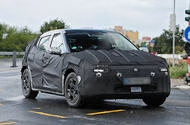What Can We Expect from the Hyundai Ioniq 2 as Hyundai Expands Its Electric Lineup?
If you’ve been keeping an eye on the electric car market, you’ve probably noticed Hyundai making some big moves lately. The upcoming Hyundai Ioniq 2 is the latest buzz, promising to slot right between the compact Inster and the more established Kona Electric. But what does that really mean for drivers, and how does this new model fit into the bigger picture of affordable EVs? Let’s break it down.
How Does the Ioniq 2 Compare to Other Hyundai Models and Its Rivals?
The Ioniq 2 is shaping up to be a sweet spot for city drivers and small families. It’s expected to be similar in size to the Hyundai Bayon—a popular combustion-powered crossover in Europe—but with a fully electric heart. That puts it in direct competition with the likes of the Renault 4 and Volvo EX30, both of which are making waves as practical, stylish EVs for urban living.
What’s interesting is Hyundai’s strategy here. By positioning the Ioniq 2 between the Inster (a compact, city-focused EV) and the Kona Electric (a slightly larger, more versatile model), they’re filling a gap that’s been wide open for buyers who want something affordable but not too basic. And with Kia’s EV2—its sibling under the Hyundai Motor Group umbrella—arriving just before the Ioniq 2, it’s clear both brands are doubling down on this segment.
When Will the Ioniq 2 Be Available, and What’s the Timeline?
Hyundai’s new Europe CEO, Xavier Martinet, has confirmed the Ioniq 2 will be revealed in the next few months, with a likely debut at the Munich Motor Show in September. That’s not far off. As for hitting the road, the Ioniq 2 is scheduled to go on sale in the third quarter of 2026, with deliveries possibly starting as early as July of that year. Kia’s EV2 is expected to beat it to market by a few months, so if you’re eager, keep an eye on both launches.
What Platform and Technology Will the Ioniq 2 Use?
Here’s where things get exciting for tech enthusiasts. The Ioniq 2 will ride on the Hyundai Motor Group’s E-GMP platform, which already underpins several of the company’s most successful EVs. This platform is known for its flexibility and efficiency, and it’s shared across Hyundai, Kia, and Genesis models.
Looking at the Kia EV3—a slightly larger cousin—we can make some educated guesses about the Ioniq 2’s specs. The EV3 offers two battery options: a 58.3kWh pack with a 267-mile range and an 81.4kWh pack stretching up to 372 miles (according to WLTP standards). Both versions use a single electric motor delivering 201bhp and 209lb ft of torque to the front wheels. While Hyundai hasn’t confirmed the exact figures for the Ioniq 2, it’s reasonable to expect similar performance and range, making it a strong contender for daily driving and longer trips alike.
What’s New Inside the Cabin? Will the Ioniq 2 Feel Different?
Hyundai is promising a “step change” in usability and interior tech. Expect a fresh infotainment system that goes beyond the basics—think ambient lighting and customizable soundscapes that adapt to your driving mode or mood. There’s also talk of a wide, unified instrument and infotainment display that stretches across half the dashboard, echoing trends seen in premium EVs.
This isn’t just about looking cool. It’s about making the car feel more intuitive and enjoyable, whether you’re commuting or heading out for a weekend adventure. Hyundai’s focus on user experience is a smart move, especially as more drivers expect their cars to feel like an extension of their digital lives.
How Much Will the Ioniq 2 Cost, and Is It Really Affordable?
Affordability is a huge selling point here. The Ioniq 2 is expected to launch at around £25,000, putting it in the same ballpark as the Kia EV2 and undercutting many rivals in the small electric crossover space. With government incentives and lower running costs, this could make EV ownership accessible to a much wider audience.
Why Is Hyundai Betting Big on the Ioniq 2 and Similar EVs?
It’s no secret that the EV market is heating up, especially in Europe. Hyundai’s strategy is to offer a full spectrum of electric vehicles, from the entry-level Inster to the flagship Ioniq 9, which is also launching soon. The Ioniq 2 will be the sixth electric model in Hyundai’s lineup, showing just how committed the company is to electrification.
Industry data backs up this approach. According to the European Automobile Manufacturers Association, electric car sales in the EU grew by over 37 percent in 2023, and demand for affordable, practical EVs is only rising. Hyundai’s move to fill every niche—without sacrificing quality or innovation—positions them as a brand to watch.
What’s the Takeaway for Drivers Considering the Ioniq 2?
If you’re looking for an electric car that’s practical, stylish, and won’t break the bank, the Hyundai Ioniq 2 is definitely worth waiting for. It promises the latest tech, a user-friendly interior, and enough range to handle both city commutes and weekend getaways. With Hyundai’s reputation for reliability and value, the Ioniq 2 could be the model that finally tips the scales for drivers still on the fence about going electric.
The EV landscape is changing fast, and Hyundai is making sure no one gets left behind. Whether you’re a longtime fan or just starting to explore electric options, the Ioniq 2 is a sign of good things to come—affordable, accessible, and ready for the real world.

